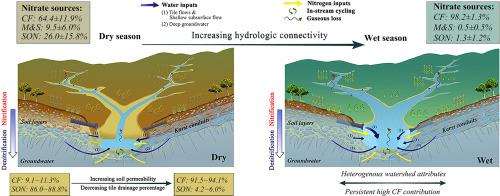当前位置:
X-MOL 学术
›
Water Res.
›
论文详情
Our official English website, www.x-mol.net, welcomes your
feedback! (Note: you will need to create a separate account there.)
Combining stable isotopes and spatial stream network modelling to disentangle the roles of hydrological and biogeochemical processes on riverine nitrogen dynamics
Water Research ( IF 11.4 ) Pub Date : 2024-11-15 , DOI: 10.1016/j.watres.2024.122800 Minpeng Hu, Zhongjie Yu, Timothy J. Griffis, John M. Baker
Water Research ( IF 11.4 ) Pub Date : 2024-11-15 , DOI: 10.1016/j.watres.2024.122800 Minpeng Hu, Zhongjie Yu, Timothy J. Griffis, John M. Baker

|
Intensive agricultural activities have significantly altered watershed hydrological and biogeochemical processes, resulting in water quality issues and loss of ecosystem functions and biodiversity. A major challenge in effectively mitigating nitrogen (N) loss from agricultural watersheds stems from the heterogeneity of N transformation and transport processes that complicates accurate quantification and modeling of N sources and sinks at the watershed scale. This study utilized stable isotopes of water and nitrate (NO3−) in conjunction with spatial stream network modeling (SSNMs) to explore watershed hydrology, N transformation, and sources within a mesoscale river network in the U.S. Corn Belt (Cannon River Watershed, Minnesota) under contrasting hydrological conditions. The results show that the wet season had elevated riverine NO3− concentration (medium: 8.4 mg N L−1), driven by high watershed wetness conditions that mobilizes NO3− from the near-surface source zone. Furthermore, the strong hydrologic connectivity also reduced the denitrification potential by shortening water travel times. In comparison, the dry season showed lower NO3− concentrations (0.9 mg N L−1) and stronger denitrification NO3− isotope signals. During this period, the decrease in hydrologic connectivity shifted the predominant water source to deep groundwater, with longer water travel time promoting denitrification. After accounting for isotopic fractionations during nitrification and denitrification, we identified fertilizer N as the main NO3− source during the wet season (98.2±1.3%), whereas the dry season showed contributions from diverse sources (64.4±11.9% fertilizer, 26.0±15.8% soil N, and 9.5±6.0% manure and sewage). During the dry season, karst regions with high hydrologic connectivity display increased shallow groundwater inputs, carrying elevated NO3− levels from leaching of applied chemical fertilizers. These findings highlight the importance of integrating drainage water management and N accumulation in groundwater into nutrient management strategies to develop adaptive measures for controlling N pollution in agricultural watersheds.
中文翻译:

结合稳定同位素和空间河流网络建模,理清水文和生物地球化学过程对河流氮动力学的影响
集约化农业活动显著改变了流域的水文和生物地球化学过程,导致水质问题以及生态系统功能和生物多样性的丧失。有效减轻农业流域氮 (N) 损失的一个主要挑战源于氮转化和运输过程的异质性,这使得流域尺度上氮源和汇的准确量化和建模变得复杂。本研究利用水和硝酸盐的稳定同位素 (NO3−) 与空间河流网络建模 (SSNM) 相结合,探讨了美国玉米带(明尼苏达州坎农河流域)在对比水文条件下的流域水文、氮变换和中尺度河流网络内的水源。结果表明,雨季河流 NO3− 浓度升高(中等:8.4 mg N L−1),这是由于高流域湿度条件从近地表源区移动了 NO3−。此外,强大的水文连通性还通过缩短水的运输时间降低了反硝化的可能性。相比之下,旱季显示出较低的 NO3− 浓度 (0.9 mg N L-1) 和更强的反硝化 NO3− 同位素信号。在此期间,水文连通性的减少将主要水源转移到深层地下水,更长的水流动时间促进了反化作用。在考虑了硝化和反氮化过程中的同位素分馏后,我们确定肥料 N 是雨季 (98.2±1) 的主要 NO3− 来源。3%),而旱季显示出来自不同来源的贡献(64.4±11.9% 的肥料、26.0±15.8% 的土壤氮和 9.5±6.0% 的粪便和污水)。在旱季,水文连通性高的喀斯特地区显示出浅层地下水输入增加,施用化学肥料的浸出导致 NO3− 水平升高。这些发现强调了将排水管理和地下水氮积累纳入养分管理策略的重要性,以制定控制农业流域氮污染的适应性措施。
更新日期:2024-11-16
中文翻译:

结合稳定同位素和空间河流网络建模,理清水文和生物地球化学过程对河流氮动力学的影响
集约化农业活动显著改变了流域的水文和生物地球化学过程,导致水质问题以及生态系统功能和生物多样性的丧失。有效减轻农业流域氮 (N) 损失的一个主要挑战源于氮转化和运输过程的异质性,这使得流域尺度上氮源和汇的准确量化和建模变得复杂。本研究利用水和硝酸盐的稳定同位素 (NO3−) 与空间河流网络建模 (SSNM) 相结合,探讨了美国玉米带(明尼苏达州坎农河流域)在对比水文条件下的流域水文、氮变换和中尺度河流网络内的水源。结果表明,雨季河流 NO3− 浓度升高(中等:8.4 mg N L−1),这是由于高流域湿度条件从近地表源区移动了 NO3−。此外,强大的水文连通性还通过缩短水的运输时间降低了反硝化的可能性。相比之下,旱季显示出较低的 NO3− 浓度 (0.9 mg N L-1) 和更强的反硝化 NO3− 同位素信号。在此期间,水文连通性的减少将主要水源转移到深层地下水,更长的水流动时间促进了反化作用。在考虑了硝化和反氮化过程中的同位素分馏后,我们确定肥料 N 是雨季 (98.2±1) 的主要 NO3− 来源。3%),而旱季显示出来自不同来源的贡献(64.4±11.9% 的肥料、26.0±15.8% 的土壤氮和 9.5±6.0% 的粪便和污水)。在旱季,水文连通性高的喀斯特地区显示出浅层地下水输入增加,施用化学肥料的浸出导致 NO3− 水平升高。这些发现强调了将排水管理和地下水氮积累纳入养分管理策略的重要性,以制定控制农业流域氮污染的适应性措施。


















































 京公网安备 11010802027423号
京公网安备 11010802027423号